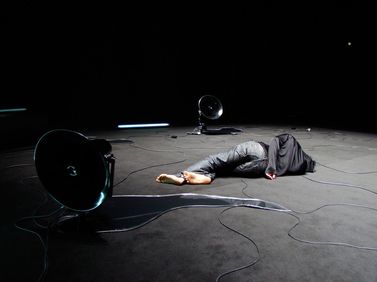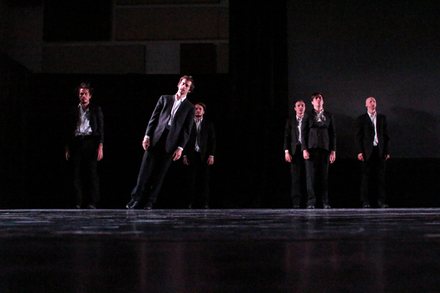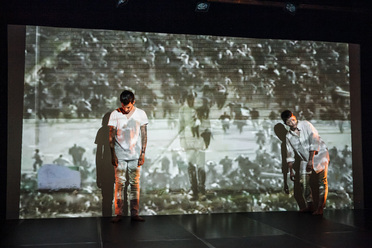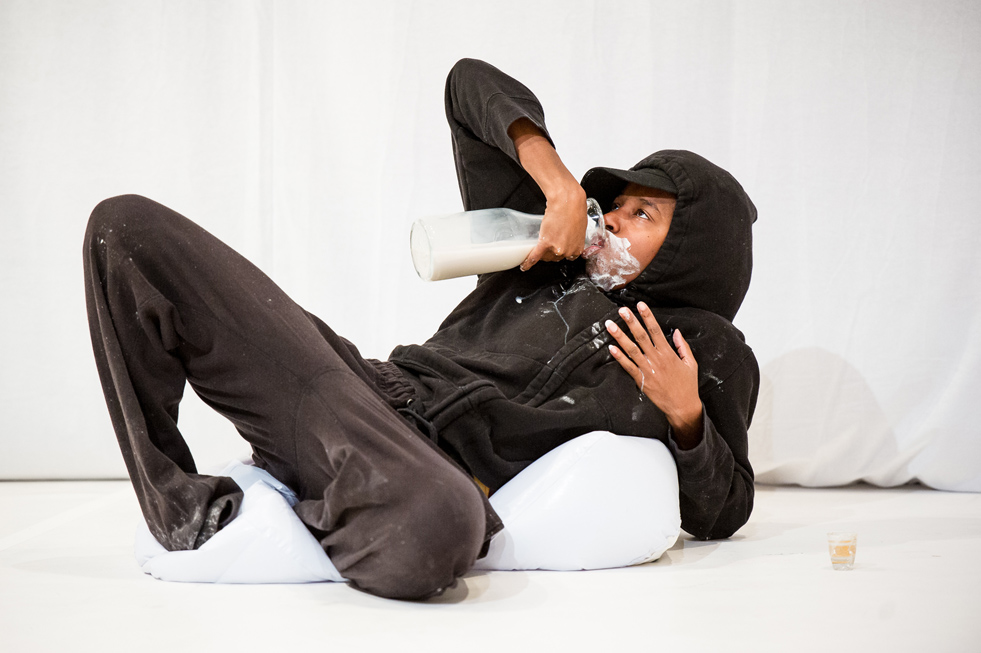Yellow Towel is messy, and not only in the literal sense that the initially immaculate off-white stage becomes cluttered with props throughout the performance. It is hard to know by which end to pick it up because the edges are all blurred, like they’ve been rubbed off against one another until we are no longer sure what we are looking at exactly. Michel has constructed a show from deconstruction, like all the elements have been passed through a blender, so that it is hard to discuss any single aspect because none of them exist as such. So as I attempt to write about Yellow Towel, I feel it’s important to note that what I am talking about doesn’t even exist, that I am taking a fragment and dusting it off in order to better be able to describe it. However, that description is a lie because the dust is just as important as the fragment.
For these reasons, there is something of an exorcism to Michell’s performance, an unfiltered quality. Words and movements pour out of the body in a seemingly uncontrolled fashion, creating odd and often humorous juxtapositions. “In the beginning,” she might blurt out, but she’s not talking about the Word, though who knows… Her speech runs like an internal monologue, mostly incomprehensible to anyone who is not her, who does not know what fills the gaps. Her body appears to be as uncontrollable as her train of thought. She is hunched over, constantly shaking. When she removes her black hoodie, Q-tips are stuck in her hair. She takes one of them to clean out her ear while blowing in a trumpet. She uses a tiny white blow-up pool as a couch, which molds her body into awkward positions as she clumsily attempts to drink milk, more running down her face than her throat. The character she creates is also elusive. When she puts on a baseball cap, it maintains her hair over her face, rendering her anonymous. Never does she look at the audience, maintaining this internal world that we only get to peek at in the moments that strike us as potentially familiar. It is easy to understand why the prestigious ImPulsTanz Festival created an award especially for Michel. Her performance is one of the most compelling we have had the chance to see in recent years. She fully commits to it, appearing like a medium whose body has been taken over by this strange creature. So, when she spends a few minutes slowly drinking from a bowl of water, we are there with her with the same intensity we would be were she actually possessed. The experience is as fascinating as it is hilarious. December 4-6 at 8pm Montréal, arts interculturels www.m-a-i.qc.ca 514.982.3386 Tickets: 25$ / Students: 20$
0 Comments
 LOIN..., photo de EM_7 LOIN..., photo de EM_7 Pour gagner, il faut tuer. C’est ce que l’une des voix désincarnées que l’on peut entendre dans LOIN… du chorégraphe français Rachid Ouramdane nous rappelle. À la guerre, il y a les tués et il y a les tueurs. La victoire n’est qu’une illusion. Dans ce solo, les voix coulent à un rythme effréné, se succèdent, nous plongent dans un univers où les guerres incessantes font éventuellement de nous tous des colons colonisés. À mesure que le temps avance, le passé se compresse sous son propre poids et, dans l’énumération des événements d’une vie, deux ans passés en prison passent aussi vite qu’une mort subite. La parole demeure toutefois vitale pour Ouramdane, ces témoignages enregistrés étant la seule chose qui puisse nous sauver de l’amnésie collective, quoi que certains intervenants semblent douter que la mémoire soit le moins pire des maux. Toutefois, le chorégraphe continue de dérouler le fil de son microphone au fil de l’histoire qu’il raconte, pour laisser une trace aussi visible que celles qui marquent l’âme des victimes directes ou collatérales de guerres et autres colonisations. La rapidité des monologues, surtout celui d’Ouramdane, évite à la sentimentalité d’infiltrer le ton de la voix, transformant cette multiplication de mots en un récit qui – à l’image de l’Histoire elle-même – nous affecte sans que l’on ne puisse toujours préciser de quelle manière, les effets concrets, mais les causes de plus en plus lointaines, notre vie que l’écho de voix que nous n’avons nous-mêmes jamais entendues. Tout sur scène est d’un noir plus moderne que gothique : l’écran vidéo, reluisante, en coin, à la verticale; les trois haut-parleurs style gramophone; les flaques statiques qui s’écoulent de ces éléments scéniques, autre trace laissée par les témoignages, visible mais dont le produit demeure mystérieux. Le tout est encadré par quatre tubes de néon. Le visage d’Ouramdane demeure surtout dissimulé sous le capuchon de son chandail, lui aussi noir, faisant écho aux visages que fragmente l’écran vidéo, étroit. Sa danse, (trop) simple, comme s’il ne voulait pas distraire du propos, rejoint la scénographie : au sol et en lenteur, à la même vitesse que les haut-parleurs qui pivotent; convulsive alors que les lumières clignotent incessamment; une marche rapide d’un côté à l’autre de la scène alors que les haut-parleurs tournent à haute vitesse... Un Américain d’origine vietnamienne dit que Bruce Lee était son héros car il semblait plus vrai que Spiderman ou Superman. « Whatever happened to heroes? » chante Ouramdane. Sur l’écran, des logos de compagnies telles que Mercedez-Benz et Fuji déferlent. Dans un système capitaliste, les compagnies deviennent les colons. L’héroïsme ne se mesure plus aux prises de position morale, mais au portefeuille. 24-26 avril à 20h MAI (Montréal, arts interculturels) www.m-a-i.qc.ca 514.982.3386 Billets : 25$  Chorus II, photo by Jasmine Allan-Côté Chorus II, photo by Jasmine Allan-Côté Sylvain Verstricht 12 Apr (4 days ago) to sasha Hi Sasha, Would you want to talk to me about your new show? Do you have time? (Preferably by email, but we could do it in person if need be. Or maybe even chatting?) I hope all is well. xo Sash 12 Apr (4 days ago) to me Hey, Email is great:) Cheers Sylvain Verstricht 12 Apr (4 days ago) to Sash You went from a "man free zone" in your last work [All the Ladies] to an all-male cast for your new show, Chorus II. Why the switch? sasha kleinplatz 13 Apr (3 days ago) to me I think it had to do with the subject matter (davening), which I remember my grandfather performing. He was a really tough guy, but when he prayed he could be so tender and meditative. I was interested in exploring that "energy" with a group of male dancers, as a way of remembering and re-writing my experiences of him. Sylvain Verstricht 13 Apr (3 days ago) to sasha Your performers come from a variety of backgrounds: different schools; some are barely out of them, others have been dancing professionally for a while... It almost seems as though you handpicked them. Why these particular men? sasha kleinplatz 13 Apr (3 days ago) to me When I first started working on this piece it was for Piss in the Pool, and I knew I wanted as many men as possible. I wanted it to be a counter-point to the twelve-women choreography I made for the pool two years earlier. I basically wrote every male dancer I knew, as well as a bunch I barely knew who were recommended to me by friends. Anybody who said "yes" was in the choreography (not the most professional method but it worked amazingly). Most of those original dancers are still in the work. Sylvain Verstricht 14 Apr (2 days ago) to sasha Since you bring it up, you have been working on it for a while... I always admired you for your rigor, so I have to ask: how do you manage to maintain interest in one piece for such a long period of time? How has it changed over time? sasha kleinplatz 14 Apr (2 days ago) to me Oh man, it is hard to stay rigorous! It isn't hard to stay interested, but it's hard to stay committed to the thread of the work and not diverge into ideas that are outside the particular choreography I am making. It helps to have collaborators who can also see the themes of the work pretty clearly; they keep you on track. The interpreters (Benjamin Kamino, Milan Panet-Gigon, Nate Yaffe, Lael Stellick, Simon Portigal, and Frédéric Wiper) are amazing for this, they all have their own experience and perceptions of the work, and if they feel like we have strayed too far from the universe we have created they will tell me. Working with a perceptive outside eye is also really integral. For this piece I have worked with three (Thea Patterson, Andrew Tay, Ginelle Chagnon), all of whom have pushed me to retain and clarify the voice of the work. It also helps to be feel a bit possessed by the work:) Sylvain Verstricht 14 Apr (2 days ago) to sasha During the public performance following your residence at Usine C, one of the dancers let his partner fall a bunch of times. Based on their interaction after the show, I assume that wasn't supposed to happen. Question: have you been experiencing massive amounts of guilt or was it their own fault? sasha kleinplatz 14 Apr (2 days ago) to me That's a hilarious question. Um, no I don't feel guilty. I am a pretty paranoid choreographer, I am constantly asking the dancers if a movement feels safe to them to execute, to a degree that the dancers have point-blank told me is very annoying. So, I had asked them about that part repeatedly before the showing, and afterwards when I asked the dancer if he was okay he basically laughed at me. Sylvain Verstricht 15 Apr (1 day ago) to sasha One last question... After you presented Chorus II at Piss in the Pool, I compared it to Édouard Lock's work (mostly just because of the black suits the men wore). I used the word "emptied" ("un Édouard Lock vidé de ses muses féminines"), which I now realize sounds pejorative, but I really meant it as a compliment. Do you hate me? sasha kleinplatz 23:44 (15 hours ago) to me No, I love you, you know that. I was kind of like "fuck, my work looks derivative!" but that's okay. Can't let Locke corner the market on men in suits. Anyways, it's all good, we are good:) April 18-20 at 8pm & April 21 at 3pm MAI www.m-a-i.qc.ca 514.982.3386 Tickets: 22$ / Students: 15$  Collective Individual, photo by YUL. Collective Individual, photo by YUL. “I fear embodying the absence ethnic war has left around me.” A legitimate fear if there is one. While only Zohar Melinek can speak of the emotional toil that the performance of Collective Individual takes on him, we can say that, though he is not a trained dancer, his performance is visibly felt and therefore honest; qualities that more than compensate for any lack of technical training. He benefits from the help of his partner from their collective Thirst/Clarity, dancer Mary St-Amand Williamson. She too seems to be more concerned with sincerity of purpose and emotion than with physical virtuosity. All the better for the subject at hand, the recent revolutions in the Arab world. The strength of the choreography is not in the symbolism of its gestures, but in the constraints they impose on the body and which differentiate it from so many others. The floor work stands heads and shoulder above the rest, like when they slowly move with their feet and head weighing them down against the floor, but their ass high in the air, triangular shapes that make their movement difficult. On the other hand, it is at its weakest when the symbolism is obvious (and therefore I must admit on the cheap side), like when Williamson is seemingly locked between four walls made of light. The physical constraints cease to be embodied and temporarily turn the performance into little more than bad miming. While a minimal amount of synchronicity is necessary for any social movement to effect change, here the choreography would be richer if the performers had less recourse to it. The movement is simple (delightfully so) and the eye would have benefited from constantly shifting between this simplicity and the density of juxtaposition. Video images of the uprising only make two brief appearances, but each time the live performers get swallowed by the mass of protesters. One can only imagine how powerful Collective Individual would be if it could represent live the energy of a sea of people and the wave they inevitably embody. The show ends with its most compelling sequence, Melinek and Williamson noisily moving while being lit by nothing but the projector projecting nothing. It confirmed my sneaking suspicion: the whole show could have taken place in that darkness. The world premiere of Collective Individual was, like any good revolution, imperfect, but promising. April 5 & 6 at 8pm MAI www.m-a-i.qc.ca www.zoharmelinek.com vimeo.com/user4058531 514.982.3386 Tickets: 22$ / Students: 15$ |
Sylvain Verstricht
has an MA in Film Studies and works in contemporary dance. His fiction has appeared in Headlight Anthology, Cactus Heart, and Birkensnake. s.verstricht [at] gmail [dot] com Categories
All
|

 RSS Feed
RSS Feed